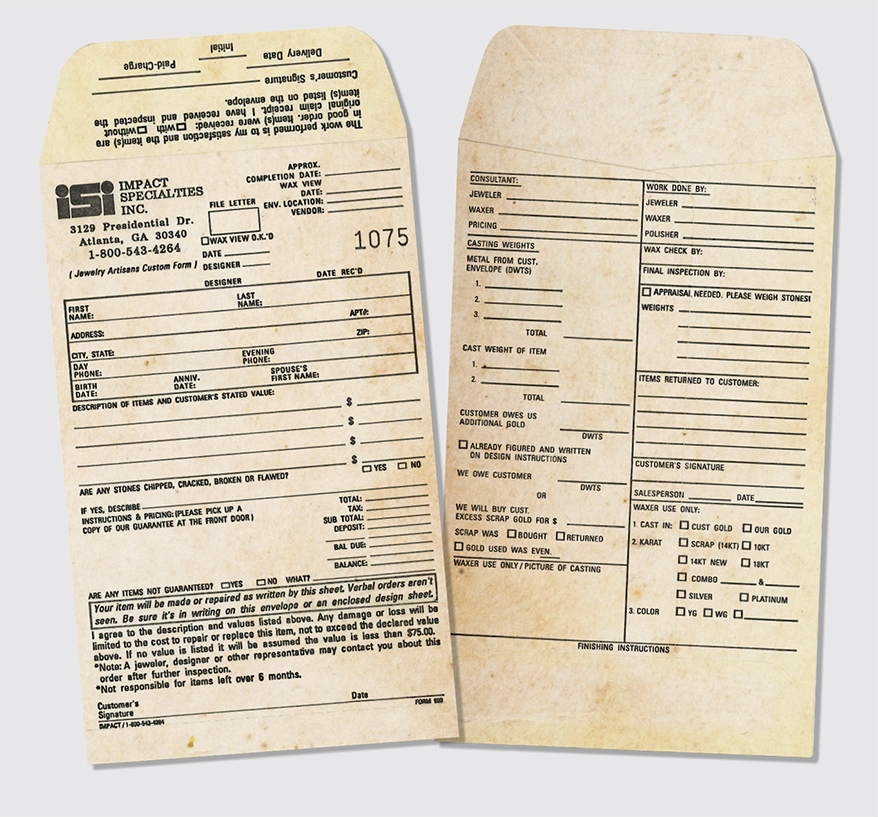
Your point of sale software likely prints job envelopes for your repair and custom work — but what goes on them?
I want to share with you the envelope we used for take-in many years ago in hopes that it may save you some headaches today.
Name Box – Notice the black rectangular box around it? I gave the customer the envelope with a pen and said, “Please fill in everything inside of this box”. It helped me during the sale because I had a hard time remembering people’s names, and it helped us after the sale with thank-you notes and birthday/anniversary mailers.
Description and Value – This describes what we took from the customer, and yes, we asked for a value. When the Jewelers Mutual agent came in yearly and asked, “How much shall we insure customers’ jewelry for?” we added up the past year’s envelope values and gave him that figure.
Are any stones chipped, cracked, broken or flawed? – This was done mainly to get the sales staff to notate this.
Advertisement
Instructions – Yes, I know this isn’t a lot of room, but we had another wide design sheet we used if we needed it that goes inside the envelope.
Are any items not guaranteed? – Every customer assumes everything is guaranteed for 12 months — and most of what we repaired was — but we notated here if we wouldn’t guarantee an item. For example, we couldn’t guarantee stone loss for small stones unless it had at least four prongs.
Your item will be made or repaired as written – This was to make sure the customer spoke up if the salesperson tried to take a shortcut by leaving off information. We didn’t accept envelopes that said “See me on this job.” This prevents miscommunication between your sales team and your jeweler.
Not responsible for items left over six months – In the state of Georgia, you’re actually required to hold a client’s jewelry for up to a year (check your own state law), but I put this on the envelope just to drive it into the customer’s brain that they couldn’t leave their stuff here.
REVERSE SIDE OF ENVELOPE
Consultant – Sales staff would fill this in as to where they got their information on what to do and pricing. Now we know who to ask.
Casting Weights – Used for designing. The foreman would put how much gold the customer might have left us to make the ring. The weights of the casting(s) are put on next lines. The foreman does addition, and for the benefit of the sales staff, the customer is going to:
Advertisement
a. Owe us some more gold
b. Will have to buy additional gold
c. If they gave us more than we needed, they can get the excess gold back (melted blob)
d. Or we will buy it from them. This is where we got a lot of gold for other clients who needed to buy extra.
Wax checked by – Someone is checking the wax prior to customer viewing, making sure it’s what they wanted and notating the envelope for the correct weight of the item.
Final inspection – Handled by shop foreman.
Advertisement
Appraisal needed, weigh stones – We also had blue stickers we placed on the front of the envelope to get the jeweler’s attention to weigh the customer’s stones before setting.
Items returning to customer – For our records in case the customer asked later. If they gave us 20 diamonds to make a ring and we used 15, five were notated. Customers signed for items returned and whoever delivered the job also signed.
Waxer use only – This tells the foreman and the person doing the casting what they need to plan for.
Finishing instructions – Anything special was notated here and this space was also used to draw pictures of the item in the envelope.